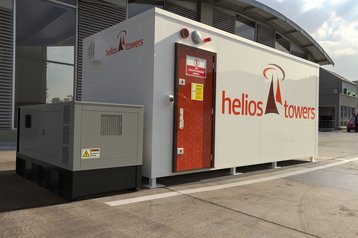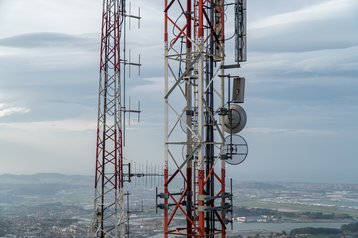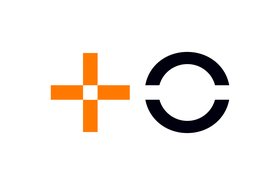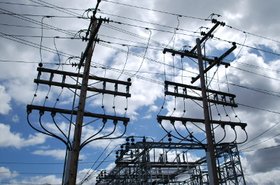"We created a new five-year strategy last year [2022], which we dubbed ‘22 by 26,’ which is to grow our operations to 22,000 towers by 2026,” Sainesh Vallabh, group commercial director and regional CEO for Southern Africa, Helios Towers, told DCD in May 2023.
Fifteen months on from our last conversation, Helios Towers’ strategy has been altered somewhat, with a new approach based around a colocation model.
The London-based company is a subsidiary of Helios Investment Partners, founded in 2004 to focus on private investment in Africa. Helios owns and operates more than 14,000 towers across nine markets, including Tanzania, the Democratic Republic of Congo, Congo Brazzaville, Ghana, South Africa, Senegal, Madagascar, and Malawi.
However, the total number of towers isn’t crucial, as Vallabh points out, it is instead the number of tenants that Helios supports. At present, that number is upwards of 28,500, per its 2024 first-half figures.
Despite the changes, the balance sheet seems to suggest the new strategy has been a success. In 2023, total revenue grew by 29 percent to $721 million, as operating profit jumped up by 82 percent.
“Since our launch of the strategy, we have shifted it to 2.2 tenants per tower by 2026. So, that's a shift from the acquisition of assets to a focus on colocations and driving a second tenant on our infrastructure, and in some cases, a third or even fourth tenant on our infrastructure, which can benefit all stakeholders,” explains Vallabh.
Small cells
Helios’ tower offerings vary, notes Vallabh, from 50-meter-tall macro towers to rooftop sites, along with others attached to street furniture such as lampposts.
Like many tower companies and mobile carriers, Helios also sees the potential in deploying small cells that take advantage of existing street assets.
Small cells are seen as a simpler alternative to bulkier telecom infrastructure, which might look out of place or draw criticism from residents.
“Availability of space, especially in urban areas, can be a challenge,” Vallabh says. “Many are overpopulated, and as a result, there's just no space to put up these towers.
“The densification of networks is going to be focused on either small cells or in-building solutions. These buildings exist already, so amplifying networks and creating densification of networks through in-building solutions is going to be key.”
Vallabh also highlights the company’s success with distributed antenna systems. While small cells function as a network of individual cells, DAS can use multiple nodes to function as a single large cell.
He points to a case study in Tanzania, where a fiber cable was deployed from the existing telecoms tower to the lampposts sitting on either side of a market. An indoor sector was additionally planned to improve basement coverage.
“This provided connectivity to 8,000 shoppers in an intense market area that wasn’t previously connected,” he says.
But, it’s not just towers and small cells that Helios counts amongst its assets. The company also owns data centers.
In 2022, Helios’ parent company, Helios Investment Partners acquired two data center companies, Morocco's Maroc Datacenter (MDC), and Kenya’s IXAfrica.
Discussing opportunities around Edge data centers across its sites, Vallabh is positive about what Edge computing can deliver and notes that the business is always looking to expand beyond its core tower and power offering into other segments such as data centers and fiber.
However, he says it will take time for Edge data centers to materialize on a wider scale across its market, due to demand.
“Looking at how the evolution of digital networks is going to play out over the next 10 years, and looking at what products need to be developed today to cater for that growth into the future. So yes, part of that is absolutely Edge data center capabilities.”
But, he says, the company has not yet “seen the level of interest from mobile operators” to have Edge infrastructure as a central part of its offering for the moment.
That's not surprising, Vallabh adds, because “the Edge requirement is only really relevant when there's extremely low latency that is needed.”
He explains: “Demand [for Edge] is created in Asia or in the US and parts of Europe, it’s very necessary there because gaming, video on demand, and streaming are very much the uses of connectivity in these markets. Whereas in Africa, it's not so much so.”
He blames this on the slower adoption of 5G, noting that 4G is still the dominant technology across the continent. Vallabh expects the emergence of a 5G ecosystem in African markets to drive these opportunities in the next decade or so.
Driving growth in Africa
Helios is intent on snapping up telecom infrastructure, which Vallabh says is often “undervalued” by mobile network carriers.
Carriers across the globe have spun off these assets and penned sale and leaseback deals with companies such as Helios, to make the quick gains necessary to fund their respective 4G and 5G network rollouts, which are often capital-intensive affairs.
“The core business of mobile operators is not to find tenants on a site, their core business is to sell airtime, so that’s where the focus, energy, and capital goes for them,” Vallabh says. “So, while underutilized, it's also under-focused by the mobile operator.
“The assets need care and they need capital and better management. As a result of that, we always see a massive improvement in network availability post the acquisition of assets from a mobile operator.”
However, in Africa the market is somewhat different, explains Vallabh, noting that the continent is behind markets such as Europe and Asia.
That much is evident when assessing the level of mobile connectivity. In more mature markets, 5G is the focus, while in Africa, telcos are focusing mainly on 4G.
A report from the GSMA estimates that mobile subscriptions in Africa will exceed 1.3 billion by 2030, as smartphone usage on the continent soars.
Helios doesn’t only operate in Africa but also the Middle East. The fourth market the company has entered in the last couple of years was Oman. It acquired 2,519 passive infrastructure sites from Oman carrier Omantel for $495 million in December 2022.
“I suppose the region in itself is probably one of the last regions where mobile network operators are looking to dispose of infrastructure,” Vallabh says.
“The US led with independent Towercos some years back, followed by Asia, while Africa was a bit later to this trend around about 10 to 12 years ago.
“In the Middle East or in GCC markets that trend is still starting, so we've seen a few potential statements or some rumors around infrastructure being disposed of, etc. I think the trend will continue in the region.”
“Cyclical” M&A opportunities
When DCD spoke with Vallabh last year, the conversation focused on the growth of the telecom tower M&A market.
It’s an industry that is constantly driving headlines, as mobile network carriers sell their tower assets to towers-focused companies such as Helios, or global investment funds.
Several African telcos, including the likes of MTN and Telkom have sold assets to tower companies.
Pushed on the possibility of expanding its portfolio of telecom towers, Vallabh says the company has slowed down on its M&A drive, which has seen it enter Madagascar, Malawi, and Senegal in the last few years.
“We're not really looking to enter into new markets at this moment in time,” he says.
“We've just entered and successfully integrated the four new markets that we entered between 2020 and 2022. Given the macroeconomic environment, the cost of borrowing, etc, we don’t want to jump into new markets at this particular time.”
That’s not to say that Helios isn’t keeping tabs on additional potential new markets, adds Vallabh.
“These things are cyclical. So there will be a time where we will start looking at new markets, and we are currently keeping an eye on where opportunities are.”
Adapting to challenges
Vallabh explains that Helios’ approach to each territory can vary, acknowledging that operating in an emerging market can present different challenges to those in more developed markets.
Providing an example of one such challenge, he notes that a lack of good roads in The Democratic Republic of the Congo (DRC) means that it can be difficult to carry out logistics at times.
“In DRC, there's very little road infrastructure, so logistically moving our infrastructure from the port or the warehouse to where it needs to be built is quite an operational focus,” Vallabh says. “If you don't get that right, then it becomes extremely difficult.”
Another challenge that the market faces is that of power supply. In South Africa, there are well-documented power infrastructure struggles, notably load shedding, an issue the country has grappled with for years.
Vallabh says that load shedding, which aims to reduce the load on a nation’s grid supply, doesn’t have too significant an impact on Helios’ operations.
“Load shedding is quite a specific element to South Africa,” he says. “There are a few markets, such as Ghana, for example, that have periodic elements of load not being available due to generation capabilities, but it's not significant.”
According to Vallabh the issue of load shedding enables Helios to engage with its customers to develop alternative solutions to work around the limitations.
The cost of delivering power to its sites can be quite expensive too, Vallabh adds, noting the rising cost of fuel for diesel generators at its sites.
Sustainability is also a challenge, particularly when trying to match the power demand needed from network carriers.
In 2021, Helios outlined plans to reduce its carbon emissions by 46 percent by 2030, and become a net-zero carbon emissions business by 2040.
“We provide power where there's virtually no power and have solutions for that, but the challenge comes where the cost of providing that solution becomes uneconomical or against sustainability objectives,” he says.
“What I mean by that is, if you are providing power to a site where there isn't a grid infrastructure then it’s most likely going to be a diesel generator. Now, of course, you can reduce the reliance on diesel generation by introducing renewable sources of energy."
One of those types of renewable energy is solar power, he points out, but it is not always an option.
“Given the loads that are required by mobile operators on the sites, it's not feasible to always rely on solar only,” he says. “The sun is only up for a certain amount of hours a day, and you have other weather considerations, so it's not a fully reliable source.”
Sometimes, having diesel generators is the easier option, he says, though these create carbon emissions.
Tower consolidation inevitable
The opportunity for expansion in the market appears strong in Africa, with Helios claiming on their website that there are around 260,000 cell towers still owned by mobile operators across the continent.
Should the telcos in Africa continue following the trend in other markets, such as Europe, Asia, and North America, and sell or lease off more of those assets, then a large chunk of those could end up being snapped up by Towercos such as Helios.
But amid the growth, Vallabh is cautious not to get carried away.
In the more immediate future, he expects market consolidation to take shape across Africa’s telecom tower market, though doesn’t comment specifically on whether Helios will engage in such opportunities.
On consolidation, Vallabh says: “Some may be forced, while some might be part of a global strategy refocus and re-shifting in terms of investment in Africa.
“The Towerco industry is becoming more competitive, as customers are becoming smarter, and understanding what specific requirements they need. There’s going to be a shift in how the Towerco model is deployed in Africa in the future.”









